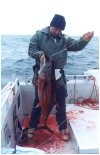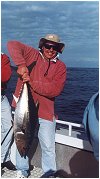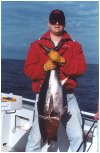Albacore or Bluefin
After many years of talk, months of waiting and weeks of planning, a humble group of 6 men, passionate about their fishing, made way on a trek that was to be one of the most memorable fishing trips they had ever been on.
The place of call was to be Pt. MacDonnell. The date: May 11th, 2001.
  The most southerly port in South Australia, and a base for a large lobster fleet, Port MacDonnell was first sighted by Lieutenant Grant in 1800, and was once South Australia's second most important port, after Port Adelaide. At nearby Cape Northumberland, the lighthouse (1882) is South Australia's most southerly light. The most southerly port in South Australia, and a base for a large lobster fleet, Port MacDonnell was first sighted by Lieutenant Grant in 1800, and was once South Australia's second most important port, after Port Adelaide. At nearby Cape Northumberland, the lighthouse (1882) is South Australia's most southerly light.
On the foreshore, the Customs House (1862) still dominates the skyline and opposite, along the shore, are maritime artefacts, some from the 50 or so ships wrecked on reefs in the vicinity. Just north is Allendale East, which has a sink-hole in the middle of the road. Mount Schank, just north again, is the youngest intact volcano crater in Australia (last eruption 2,000 years ago) and the Little Blue Lake, 3km west of the Mount Gambier Road.
As with any fishing trip, expectations of good catches tend to run high. In this instance, they were astronomical, given the fact that previous reports of catches of albacore and bluefin were a regular occurrence in recent weeks. Our facilitator for the trip was the skipper and owner of Pt. MacDonnell Fishing Charters, Jason Fulham, a man with several years experience at the helm, and extremely knowledgeable with the waters off Pt. MacDonnell.
  Our day started at 7.00am, where we all boarded the boat Apollo and set off towards the continental shelf which lay some 17 miles to our south. The trip took around 90 minutes, where we immediately rigged up our lines with lures. I blessed the rod I was using with a Yo-Zuri Hydro Magnum (140mm) and we started trolling the area at a speed of around 7 knots. Our day started at 7.00am, where we all boarded the boat Apollo and set off towards the continental shelf which lay some 17 miles to our south. The trip took around 90 minutes, where we immediately rigged up our lines with lures. I blessed the rod I was using with a Yo-Zuri Hydro Magnum (140mm) and we started trolling the area at a speed of around 7 knots.
It wasn't till about 10.00am that we had our first strike, a nice sized tuna which, and as you can see, seemed to bleed forever. Albacore tuna have a long, pronounced pectoral fin, where as the Bluefin's is smaller. This fish was an Albacore tuna. This particular fish, landed by Paul, took only 15 minutes to bring in and weighed around 14 kg.
The state of the sea at times was that of around 5 ft swells, and had adverse affects on some of us. Let us just say that someone didn't clean up their vomit off the side of the boat. Chinook unfortunately is a sympathetic puker - he feels sorry for anyone that pukes, and tends to exhibit their symptoms as well !
  Now, try and visualise this situation - It's mid afternoon, the boat is trolling at a leisurely 7 knots, haven't had a hit since 10.00am, a group of guys standing around and talking, paying only cursory attention to their lines. Suddenly, ALL rods register HUGE hits with the boat having apparently passed through a school of tuna. Within a micro-second, the same casual group of guys all spring into action towards their respective rods, without collision or mishap. Now, try and visualise this situation - It's mid afternoon, the boat is trolling at a leisurely 7 knots, haven't had a hit since 10.00am, a group of guys standing around and talking, paying only cursory attention to their lines. Suddenly, ALL rods register HUGE hits with the boat having apparently passed through a school of tuna. Within a micro-second, the same casual group of guys all spring into action towards their respective rods, without collision or mishap.
 The next 25 minutes were furious, as we all tried to reel our quarries in, without tangling our lines in the process. We were having to move under or over each other's lines, from one side of the boat to the other, as the tuna were fighting, and desperate in avoiding being landed. The next 25 minutes were furious, as we all tried to reel our quarries in, without tangling our lines in the process. We were having to move under or over each other's lines, from one side of the boat to the other, as the tuna were fighting, and desperate in avoiding being landed.
 As can be seen, of the six tuna hooked, 4 were landed. Once the tuna were bled and allowed to have their spasm attacks on deck, they were placed into the kill tank, the deck hosed down, we set upon untangling our lines, shook hands and had a beer. As can be seen, of the six tuna hooked, 4 were landed. Once the tuna were bled and allowed to have their spasm attacks on deck, they were placed into the kill tank, the deck hosed down, we set upon untangling our lines, shook hands and had a beer.
I have never seen bigger smiles on a bunch of guys than the ones shown here. From left to right are, Michael Webley, Geoff Stedman, Chinook and Coho. The photo on the right, Coho looks extremely pleased with his Bluefin. As for the other two guys who missed out on landing their first ever tuna, well, I don't really want to talk about it, and neither does Oshim Somers !! 
It is important to bleed the tuna and place them in a kill tank quickly. When they fight, tuna work very hard and they cant go down deep to cool off. They are a very muscular fish for the size, with their fluid-dynamic design allowing for quick traversing through the oceans, at depths at which they swim to keep themselves cool.
The current theory is that tuna hang deep to travel and go to the surface for a few minutes to crash around and feed - then dive to cool off again. Hence, one that as only been up for a short time is harder to fight than one that has been up for awhile, regardless of size.
  As you can see, Coho, on the right, is extremely photogenic when it comes to showing off a prized catch, especially when he doesn't have that glazed look in his eyes - and we all know how he gets that !!
As you can see, Coho, on the right, is extremely photogenic when it comes to showing off a prized catch, especially when he doesn't have that glazed look in his eyes - and we all know how he gets that !!
The shot on the left shows Geoff Stedman with his tuna. Geoff is an interesting fellow, where by he religiously practices the art of ocean fly fishing, given the opportunity. To date he has caught, on flies, a Snapper, Mulloway, Australian Salmon, Flathead and was hoping for a tuna, but to no avail. He has a web site which shows some great photos and story lines, all fish caught using a fly rod. Well worth a visit.
Geoff's Web Site is http://www.frequentflyrodders.com/.
As they say, a perfect end to a perfect day's fishing - if you exclude the two people who were skunked. Either way, this trip I believe was the first of many to be made by us to Pt. MacDonnell, where tuna fishing definitely offers the exhilarance and excitement that most fishermen dream about and wish for.
Don't forget, the tuna that was caught here was smaller than the norm, each weighing about 13kg. Fish such as Blue Eye Trevally, Hapuka and Mako Sharks are also prevalent in the area, and deep sea fishing is an alternative, if you are willing to retrieve 500m of line from the bottom, with a 2kg sinker at the end of it !!
On a final note, I must give thanks to Jason Fulham, owner/skipper of Pt. MacDonnell Fishing Charters, in providing us with a day's fishing we will not soon forget. Special thanks also goes to Andrew & Gretel Sneath in their provisions of accommodation in a well maintained, clean and spacious house. The combustion heater was a must to use, and great to sit by at nights, as it gets extremely cold down south.
Pt. MacDonnell Fishing Charters provides package deals for Fishing/Accommodation. The fishSA Review for this Charter Service is well worth the read, should you require more information on Pt. MacDonnell Fishing Charters & Accommodation.
 Fishing Tip : Fishing Tip : |
|
| Why not contact fishSA.com about your Fishing Tip |
|
|